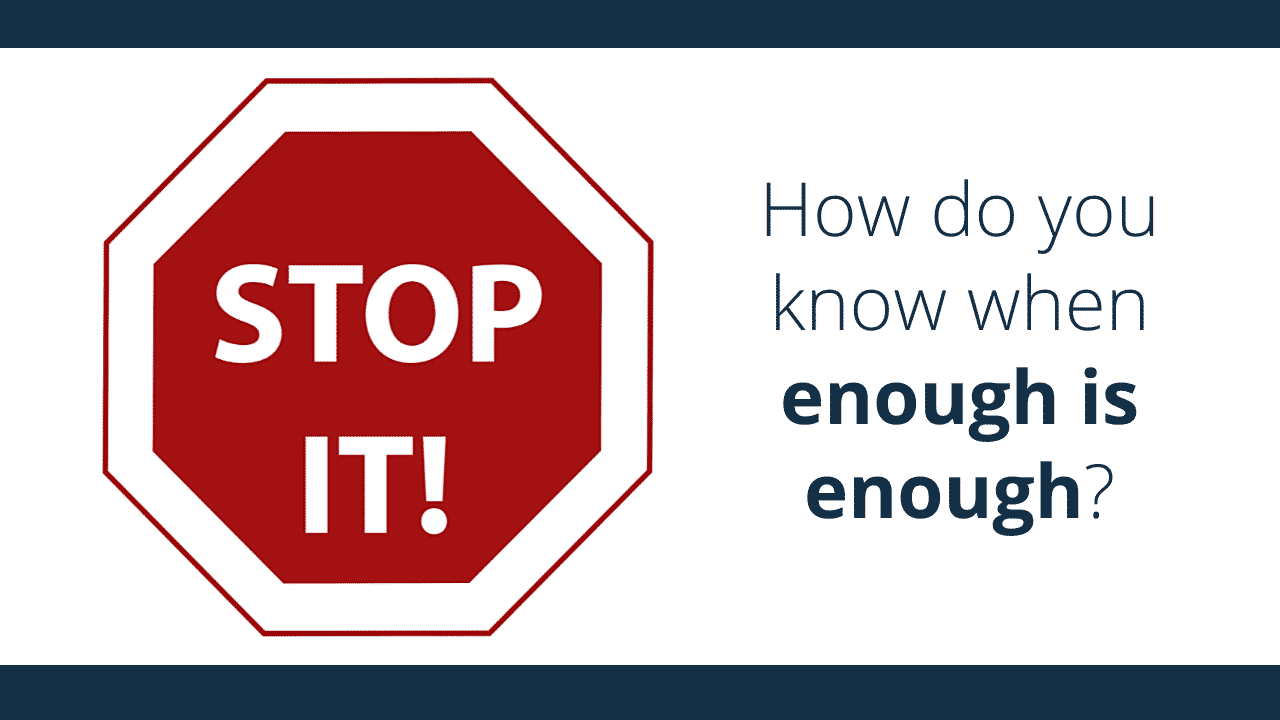How do you know when enough is enough?

For the past few months, I’ve been returning again and again to this question, “How do you know when enough is enough?
I will give you an example of what I mean. Over the summer, my kids were at camp and I put together two care packages for them. It involved a whole lot of shopping at Target looking for whatever knick-knacks that kids who have more than enough could possibly want at camp, and lots and lots of baking (for one of my kids that can receive food in his package.)
And yet I still wondered if I had done enough.
Texting with a good friend this morning I heard the same theme – she was feeling guilty that she hadn’t gone to her parents that day to help out with an emerging need, since her schedule was already filled with client calls and commitments.
I keep thinking of this old Bob Newhart clip that circulates from time to time with the key line being “Just Stop It!” (If you haven’t seen this 5 min clip – it’s worth it!)
For the past few months, I’ve been returning again and again to this question, “How do you know when enough is enough?
If you’re combatting climate change, what’s enough? It’s unlikely you can be loud enough or do enough on any single day to make a difference. Although I do hope that years of effort by many people can amount to large scale change. If you’re marching for racial equity, when can you stop marching each day? I fervently believe that for both climate change and racial equity, the work these leaders are doing makes a huge impact and changes our world. Yet it’s unlikely in the near-term that their work will be done.
And so I think this is the conundrum that many of us live with. Our work matters. We matter. But there’s no end-date in sight.
Peter Senge, a famous organizational expert and thought leader gave an amazing analogy in his book “The Fifth Discipline.” He talked about how organizational learning is like a rubber band that you stretch between two hands, where on the bottom hand, you have where the organization currently is and on the top hand, you have where the organization would like to be. This gap between where we are and where we want to be is the creative tension.
According to Senge, when organizations improve, there will be some slack in the rubber band as they move closer to their goal, but then they often move the goal higher, and the tension returns to the rubber band.
This is very present in my own life and work right now. As much as I do, learn and grow, there are still more organizations I want to be helping, a bigger impact I want to make and more knowledge I need to help me make that impact. My biggest takeaway, courtesy of Peter Senge and my own coach, is that being an ambitious, purpose-driven person and leader, means finding ways in yourself to always be living in that creative tension.
I don’t stop working every day because my to-do list is complete. I don’t close out of emails because I have inbox-zero. And I don’t stop learning, reading and taking classes because I’ve mastered it all.
I stop because when it’s never enough, you have to become the architect of your own experience. Do you want the experience of living life stressed, under the gun and always behind? Or is that not enough for you?
I want the experience of love, sending enough care packages that my kids know they are loved, but not so much that they are overwhelmed by that love.
I want the experience of beauty and friendship, hikes that can’t happen when you’re stuck in front of your computer screen.
And I want the experience of pleasure, knowing that I can close my laptop for a few days (or a whole vacation) to be fully present in my life outside of work while knowing that the world won’t end and that filling up my soul outside of work and #goals, is what allows me to be fully present when I’m back at work and striving towards those ever-changing #goals.
What experience of life do you want to have? Leave a comment below – I love hearing from you!